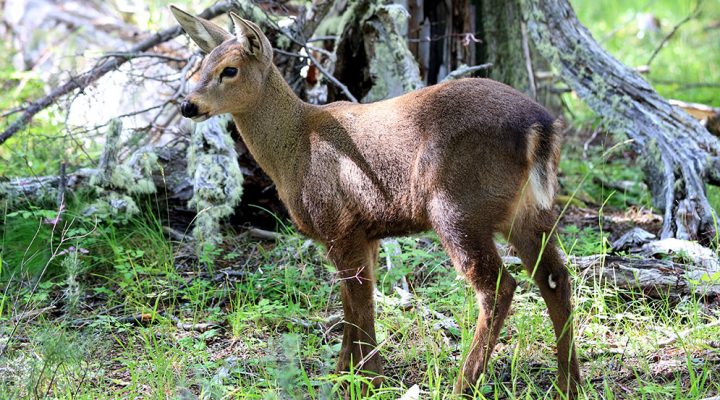BIOLOGICAL AND HEALTH SCIENCES
A plan to save the huemul deer is moving forward in the Province of Chubut
The rehabilitation and breeding station, recently founded with the participation of a CONICET researcher, saw the birth of the first deer last November. It has been more than seven decades since an animal of this endangered species was born in captivity in Argentina.
Last November, the first huemul (Hippocamelus bisulcus) was born at the recently created “Shoonem Rehabilitation and Breeding Station”, which operates under the supervision of the Shoonem Foundation in the Chubut Province.
It has been more than seven decades since a huemul was born in captivity in Argentina. In 1936, a small group of these deer were taken to the Zoological Garden of the city of Buenos Aires, where they had offspring, and in the 1930s, a Zoological Station was established in Neuquén by National Parks, where huemul births took place, but this project was abandoned in 1945.”It is a male and is still growing well, healthy and full of energy”, says Werner Flueck, CONICET researcher at the “Nahuel Huapi” National Park, under the National Parks Administration, and one of the founders of the station created to try to rescue the southernmost deer in the world from extinction.
“The calf born at our station was named Shehuen, which in the Tehuelche language means ‘source of light,’ alluding to the hope that its birth will contribute to the recovery of the species,” Flueck says.
The purpose of the Rehabilitation and Rearing Station, Flueck explains, is to generate groups of huemul to reintroduce them into environments of high nutritional quality that were historically occupied by the huemul. “This will allow them to increase their population and expand to neighboring areas. Ideally, the future subpopulations, -which today are separated and isolated- will be able to reconnect and reproduce. A recovery of this type entails the need to coexist with humans, particularly because the huemul has little or no fear of people, which has caused its local extermination by overhunting,” explains the CONICET researcher.
In Argentina, only three to five hundred huemuls remain, fragmented in about 60 groups along 1800 km of the Andes, with one of the most prominent groups (subpopulations) in the Shoonem Protected Park, located in the Senguer River basin, where research work is being carried out with the support of the Direction of Flora and Fauna of Chubut Province. Although confined today to the high areas of the Andean mountains due to overhunting, in the past, they used to also inhabit open areas (prairies) and evidence of their presence has even been found at the Atlantic coast.
With a grant from the Erlenmeyer Foundation of Switzerland, Flueck and his colleagues at the Shoonem Foundation were able to complete the construction of the breeding and rehabilitation station by mid-2022 and are now seeking additional funds to meet all the logistics required for the project. With the co-participation of the Temaiken Foundation, they were able to make captures in August 2022 to transfer the first huemuls – five in total – to the Shoonem Station and start the project.
As a CONICET researcher, Flueck has led and participated in almost 70 scientific articles, and written chapters and books on different aspects of huemul life: health, anatomy, behavior, nutrition, ecology, their current and historical distribution, breeding and conservation. “Among other things, our studies have shown that when huemuls are confined to high altitudes in the Andes, they feed on forage that is extremely poor in certain minerals. For this reason, they develop bone diseases and lose their teeth, without which they cannot feed well,” explains the scientist. In fact, says Flueck, the “Shoonem Rehabilitation and Breeding Station” is based on a semi-captive system, i.e. the huemuls live in an area whose size and vegetation allow them to travel considerable distances and access appropriate amounts of water and food. “If necessary, supplementary feeding can be provided. Every day, we monitor them by way of their radio-collars, and sometimes we approach them to evaluate their health and behavior,” explains the researcher.
The birth of “Shehuen”
Shehuen was born on November 5. As he grew, the calf began to walk, run and jump.”He is a well-developed fawn; his birth weight must have been between five and six kilograms (kg),” says Flueck and adds, “At over three months of age, he is still nursing, which indicates his mother is in good health. Yet, he now spends most of his time feeding, either browsing or grazing”.
Adult huemuls usually weigh between 70 and 90 kg and reach a meter in height. “As the main native herbivore in certain environments, the huemul plays an important role in these ecosystems and this is another reason to prevent its extinction,” emphasizes the CONICET researcher.
Flueck also points out that the station’s objectives are to rehabilitate huemul deer in poor health; to encourage breeding of these individuals in order to conduct future reintroductions of their offspring to sites where the huemul species had already been extirpated; and to facilitate the scientific study of topics that have not been fully analyzed.
“It will be essential that certain areas historically populated by huemul have an adequate level of protection to allow their recovery and educate the local inhabitants to care for this species,” says Flueck. And he continues: “This could be in national parks and also on private lands which could receive incentives to support a future coexistence with the huemul. The most fertile areas, such as valleys or pampas, are generally populated or used by human populations. Being able to inhabit these regions again will allow the huemul to live healthier and longer, which would translate into an increase in their reproduction and population growth rates”.
By Bruno Geller
English version: Werner Flueck
